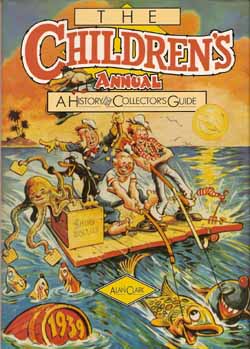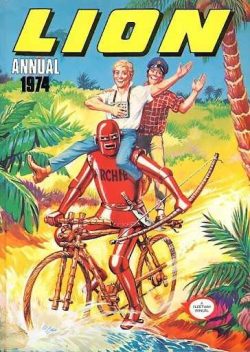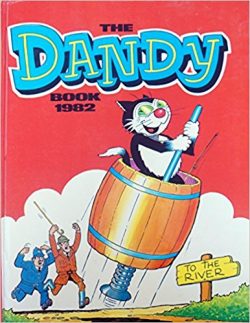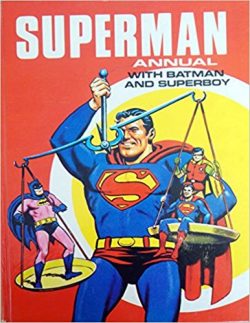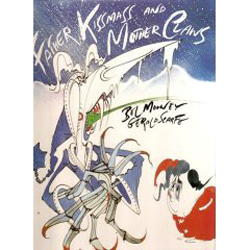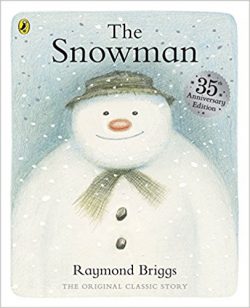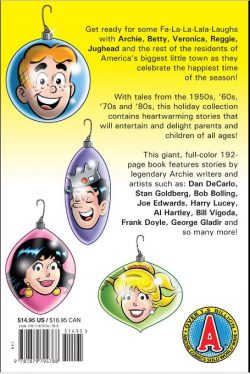
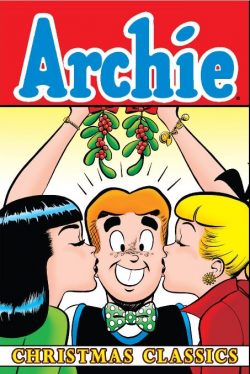
By Frank Doyle, Harry Lucey, George Gladir, Dan DeCarlo, Bill Vigoda, Tom Moore, Bob White, Al Hartley, Stan Goldberg, Joe Edwards, Bob Bolling & various (Archie Comics)
ISBN: 978-1-879794-78-8
Win’s Christmas Gift Recommendation: For All Those Who’ve Been Extra Good This Year… 9/10
As long-term readers might recall, my good lady wife and I have a family ritual we’re not ashamed to boast of or share with you. Every Christmas we barricade the doors, draw the shutters, stockpile munchies, stoke up the radiators and lazily subside with a huge pile of seasonal comics from yesteryear.
(Well, I do: she also insists on a few monumental feats of cleaning and shopping before manufacturing the world’s most glorious and stupefying meal to accompany my reading, gorging and – eventually, inevitably – snoring…
Oh, so much snoring!!!)
The irresistible trove of funnybook treasures generally comprises older DC’s, loads of Disney’s and some British annuals, but the vast preponderance is Archie Comics.
From the earliest days this American institution has quite literally “owned Christmas†through a fabulously funny, nostalgically charming, sentimental barrage of cannily-crafted stories capturing the spirit of the season through a range of cartoon stars from Archie to Veronica, Betty to Sabrina and Jughead to Santa himself…
For most of us, when we say “comicbooks†people’s thoughts turn to steroidal blokes, anthropomorphic animals and even women in garish tights hitting each other, bending lampposts and lobbing trees or cars about.
That or stark, nihilistic crime, horror or science fiction sagas aimed at an extremely mature and sophisticated readership of confirmed fans…
Throughout the decades though, other forms and genres have waxed and waned. One that has held its ground over the years – although almost completely migrated to television these days – is the genre of teen-comedy begun by and synonymous with a carrot topped, homely (at first just plain ugly) kid named Archie Andrews.
MLJ were a small publisher who jumped on the “mystery-man†bandwagon following the debut of Superman. In November 1939 they launched Blue Ribbon Comics, promptly following-up with Top-Notch and Pep Comics. Content was the standard blend of costumed heroes and two-fisted adventure strips, although Pep did make a little history with its first lead feature The Shield, who was the American industry’s first superhero to be clad in the flag (see America’s 1st Patriotic Hero: The Shield).
After initially revelling in the benefits of the Fights ‘N’ Tights game, Maurice Coyne, Louis Silberkleit and John Goldwater (MLJ, duh!) spotted a gap in their blossoming market. In December 1941 their stable of costumed cavorters and two-fisted adventurers were gently nudged aside – just a fraction at first – by a wholesome, improbable and far-from-imposing new hero; an unremarkable (except, perhaps, for his teeth) teenager who would have ordinary adventures just like the readers, but with the laughs, good times, romance and slapstick emphasised.
Almost certainly inspired by the hugely popular Andy Hardy movies, Goldwater developed the concept of a youthful everyman protagonist and tasked writer Vic Bloom & artist Bob Montana with the job of making it work. Their precocious new notion premiered in Pep #22: a gap-toothed, freckle-faced, red-headed kid obsessed with impressing the pretty blonde girl next door.
An untitled 6-page tale introduced hapless boob Archie Andrews and wholesomely pretty Betty Cooper. The boy’s unconventional best friend and confidante Jughead Jones also debuted in the first story, as did idyllic small-town utopia Riverdale. It was a huge hit and by the winter of 1942 the kid and his pals won a title of their own.
Archie Comics #1 was MLJ’s first non-anthology magazine and with it began a slow transformation of the entire company. With the introduction of ultra-rich, raven-haired Veronica Lodge, all the pieces were in play for the industry’s second Genuine Phenomenon…
By 1946 the kids were in charge, so MLJ became Archie Comics, retiring most of its costumed characters years before the end of the Golden Age to become, to all intents and purposes, a publisher of family-friendly comedies. The hometown settings and perpetually fruitful premise of an Eternal Romantic Triangle – with girl-hating best bud Jughead Jones and scurrilous rival Reggie Mantle to test, duel and vex our boy in their own unique ways – the scenario was one that not only resonated with the readership but was infinitely fresh…
Archie’s success, like Superman’s, forced a change in content at every other publisher (except perhaps Gilberton’s Classics Illustrated) and led to a multi-media brand which encompasses TV, movies, newspaper strips, toys and merchandise, a chain of restaurants and, in the swinging sixties, a pop music sensation when Sugar, Sugar – from the animated TV cartoon – became a global pop smash. Clean and decent garage band “The Archies†has been a fixture of the comics ever since…
The Andrews boy is good-hearted, impetuous and lacking common sense, Betty his sensible, pretty girl next door who loves the ginger goof, and Veronica is rich, exotic and glamorous: only settling for our boy if there’s nobody better around. She might actually love him too, though. Archie, of course, is utterly unable to choose who or what he wants…
Unconventional, food-crazy Jughead is Mercutio to Archie’s Romeo, providing rationality and a reader’s voice, as well as being a powerful catalyst of events in his own right. That charming House of Luurve (and Annexe of Envy) has been the rock-solid foundation for seven decades of funnybook magic. Moreover, the concept is eternally self-renewing…
This eternal triangle has generated thousands of charming, raucous, gentle, frenetic, chiding and even heart-rending humorous dramas ranging from surreal wit to frantic slapstick, with the kids and a constantly expanding cast of friends… (boy genius Dilton Doily, genial giant jock Big Moose and aspiring comicbook cartoonist Chuck amongst many others) growing into an American institution and part of the nation’s cultural landscape.
The feature has thrived by constantly re-imagining its core archetypes; seamlessly adapting to the changing world outside its bright, flimsy pages, shamelessly co-opting youth, pop culture and fashion trends into its infallible mix of slapstick and young romance. Each and every social revolution has been painlessly assimilated into the mix and, over the decades, the company has confronted most social issues affecting youngsters in a manner always both even-handed and tasteful.
Constant addition of new characters such as African-American Chuck and his girlfriend Nancy, fashion-diva Ginger, Hispanic couple Frankie and Maria and spoiled home-wrecker-in-waiting Cheryl Blossom have contributed to a wide and appealingly broad-minded scenario. In 2010 Archie easily cleared the American industry’s final hurdle when openly gay Kevin Keller became an admirable advocate, capably tackling and dismantling the last major taboo in mainstream Kids’ comics.
One of the most effective tools in the company’s arsenal has been the never-failing appeal of seasonal and holiday traditions. In Riverdale it was always sunny enough to surf at the beach in summer and it always snowed at Christmas…
The Festive Season has never failed to produce great comics stories. DC especially have -since their earliest days – perennially and effectively embraced the magic of the holiday with a decades-long succession of stunning and sentimental Batman thrillers, as well as many other heroic team-ups incorporating Santa Claus, Rudolph the Red-Nosed Reindeer, Sgt. Rock and all the rest…
Archie also started early (1942) and kept on producing memorable year-end classics. The stories became so popular and eagerly anticipated that in 1954 the company created a specific oversized title – Archie’s Christmas Stocking – to cater to demand, even as it kept the winter months of its other periodicals stuffed with assorted tales of elves and snow and fine fellow-feeling…
Seasoned (see what I did there?) with covers and pin-ups, this splendidly appealing, full-colour celebration – recently re-released as an eBook – gathers a superb selection of Cool Yule extravaganzas from those end-of-year annuals and other sources.
Without preamble the jolly japes commence with a selection from Archie Giant Series #6: Archie’s Christmas Stocking 1959.
‘Slide Guide!’ by the irrepressible team of Frank Doyle & Harry Lucey highlights Reggie and Archie’s bid to out-do each other impresses a pack of youngsters of the danger of sledding, after which ‘Snow Mistake!‘ (Doyle & Bill Vigoda) sees the rivals unite when Veronica dates another boy. Their scheme to set ever-enraged schoolmate Big Moose on the new kid goes agonisingly amiss though…
‘Fire Bugged’ (Doyle & Dan DeCarlo) then reveals how helpful Archie’s attempts to prove Christmas trees are a fire hazard enflames and enrages Ronnie’s dad, whilst ‘Come Onna My House’ (Doyle & Vigoda) details the minor spat of BFFs Betty and Veronica as they decide who will host Archie on Christmas morning…
Tom Moore reveals untrammelled greed in one-pager ‘Archie’s Pal Jughead in Shocking Stocking!’ before – following a racy Veronica the X-Mas elf pin-up – ‘Not Even a Moose’ (Doyle & Vigoda) leads off topical tales from Archie’s Christmas Stocking #10, 1961.
Here Reggie plays foolish pranks on the naïve giant and discovers the danger of telling people there is such a man as Santa whilst ‘Those Christmas Blues!’ (Bob White) sees Archie’s parents lament that they’ve been side-lined in favour of the girls in their boy’s life but have a wonderful surprise awaiting them…
Two half-pagers ‘A Head Start’ and ‘Reggie: Generous to a Fault’ segues into Betty and Veronica’s Coloring Page (not so engrossing if you’re reading the eBook edition!) after which a bad cold afflicts a close friend and causes a catastrophic case of Chinese Whispers in regard to gift-giving in ‘Archie’s Pal Jughead: “Code Three‒ (Doyle & Vigoda).
Archie’s job as guardian of the year’s presents results in a catastrophic mess in ‘Gift Collection’ after which Betty and Veronica experience a just comeuppance for calling the boys slobs in ‘Do No Evil’ (Doyle & DeCarlo: Archie Giant Series #6: Archie’s Christmas Stocking 1959)
Following a suitably seasonal Mr. Weatherbee Pin-up Page and Jughead single-page gag ‘More Pull than Talent!’, Archie and Reggie clash over a present for Veronica in ‘Go for Broke’ (from Archie Giant Series #4: Archie’s Christmas Stocking 1957) after which ‘Boxed In’ sees the red-headed fool outsmart himself in his quest for the perfect present…
Archie’s Girls Betty and Veronica: ‘R is for Rooked’ (DeCarlo from Archie Comics Digest #3, December1973) sees reluctant go-between Jughead botch a spy mission to find out what Ronnie’s buying Archie whilst ‘Black Book Bonanza’ (same guy, same source) discloses how Moose comes to believe he’s now one of Santa’s official helpers…
Skulduggery and intrigue inform Doyle & Bob White’s ‘A Christmas Tale’ (Life with Archie #33, January 1965) as Ronnie promises a month of dating exclusivity to whomever chops down the biggest charity Christmas Tree. When Archie and Jughead team up to ensure the Andrews boy wins, Betty and Reggie unite to scotch their plans…
Archie Giant Series #150: Archie’s Christmas Stocking January 1968 supplies single page Veronica gag ‘Prize Surprise’ (by George Gladir & Al Hartley), leads into ‘Treed’ (Doyle & Hartley) as mystic Xmas elf Jingles helps Archie survive Reggie’s latest campaign of Christmas terror after which Archie and the Gang Make their Christmas Wish’ (Hartley) and
Christmas Pin-up (DeCarlo) bring us to ‘Wanted: Santa Claus’ (Life with Archie #26, February 1969) with Mr. Weatherbee in a turmoil because he thinks the Andrew’s boy has usurped his annual role as the school Kris Kringle…
A ‘Merry Christmas Dear Reader’ ensemble pin-up leads into sentimental tearjerker ‘It’s Not the Gift’ as Archie saves a young kid from a tragic Christmas before Doyle, Lucey & Mario Acquaviva reveal how garage-band The Archies appal and offend the older generation with their ‘Ode to Santa’ (from Laugh Comics #215 February 1969) after which Archie Giant Series #150 provides DeCarlo’s ‘Christmas Fashions for Betty and Veronica’.
‘Temptation’ (Doyle, Lucey & Chic Stone; Archie #232 February 1974) then proves Jughead very wise indeed after he argues that even Reggie can’t resist the good feelings of Christmas and – following an Archie Pin-up – ‘Shopper Comes a Cropper’ (Gladir, Lucey & Stone) finds Archie in the same old bind after double-booking Christmas shopping with both Betty and Ronnie…
Doyle, DeCarlo & Rudy Lapick examine the bleaker side of the season in ‘The Greatest Gift’ (Life with Archie #154, February 1975) as the gang befriend a lonely and embittered old shopkeeper, whilst – after a Lucey Archie’s Coloring Page – Betty and Ronnie declare war on each other’s trimming and decorating taste in ‘Tree Spree’ (Archie Giant Series #242: Archie’s Christmas Love-In: January 1976).
‘Spirit Sprite’ (Archie Giant Series #454: Archie’s Christmas Love-In: January 1977) sees the Riverdale kids working to get Jughead and Big Ethel together under the mistletoe before Betty and Archie overcome exorbitant prices and circumvent ‘Tree Travail’ with a public display of seasonal cheer whilst Mr. Lodge counters his own financial worries by joining Santa’s ‘Aid Parade’…
Wrapping up the festivities is prose yarn “Christmas Jeer†(Archie’s Girls Betty and Veronica #16; January 1955) as the friendly rivals’ clash over duplicate dresses threatens to derail the big Christmas party…
These are joyously effective and entertaining tales for young and old alike, crafted by some of Santa’s most talented Helpers, epitomising the magic of the Season and celebrating the perfect wonder of timeless all-ages storytelling. What kind of Grinch could not want this book in their kids’ stocking (from where it can most easily be borrowed)?
© 2011 Archie Comics Publications, Inc. All rights reserved.
